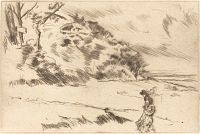Speke Shore | ||
| Number: | 139 | |
| Date: | 1875 | |
| Medium: | drypoint | |
| Size: | 155 x 230 mm | |
| Signed: | no | |
| Inscribed: | no | |
| Set/Publication: | 'Cancelled Plates', 1879 | |
| No. of States: | 4 | |
| Known impressions: | 21 | |
| Catalogues: | K.144; M.142; W.119 | |
| Impressions taken from this plate (21) | ||
KEYWORD
beach, landscape, tree, weather, wind, woman standing.
TITLE
The drypoint appears to have always been known by the same title. Examples include:
'Speke Shore' (1877, Whistler). 4
'Speke Shore' (1899, Frederick Wedmore (1844-1921)). 5
Whistler's original title, 'Speke Shore', which is clear and descriptive of the subject, corresponds to that used by later cataloguers.
'Speke Shore' (1877, Whistler). 4
'Speke Shore' (1899, Frederick Wedmore (1844-1921)). 5
Whistler's original title, 'Speke Shore', which is clear and descriptive of the subject, corresponds to that used by later cataloguers.
4: 19 October [1877], GUW #12735.
5: Wedmore 1899[more] (cat. no. 119).
DESCRIPTION
In the right foreground, a woman is walking to left over grass-covered low dunes towards a wooded bank. The woman is looking down, holding up her trailing skirt. She wears a close-fitting jacket with a stand-up collar, and a wide-brimmed hat with the veil blowing out behind her. Beyond her, to right, is a stretch of beach and sea under a lowering sky. A signboard is nailed to one of the trees at top left.
SITTER
It is possible that the woman walking on the beach is Frances Leyland (1834-1910). She probably also appears in a related etching, Speke Hall: The Avenue 101. However, it could be another member of the Leyland family or Elizabeth Dawson (b. 1840).
SITE
This shows the beach adjoining the grounds of Speke Hall, Lancashire, near Liverpool. Whistler had commented - several years earlier - on the unfavourable scenery:
'The sea I thought I would go and look at as a sort of change - ... However, it all fell through - ... as to the sea - it was nowhere at all! .... the beach being as flat and as level as a waxed floor, whenever the tide went down the sea went straight out of sight! - ... not only was high tide at about four and five in dull afternoons when there [was] barely light enough to look for it, but even then these tides were the lowest during the whole year - and the wind blowing from the land the whole affair was as flat and stupid as the sky above muggy and shapeless - Waves there were none of course and so after waiting three or four days I came away disgusted ...' 6
Similarly, Whistler's biographers, the Pennells commented:
'The record of these visits is in the etchings
and dry-points of Speke Hall and Speke Shore, Shipping at
Liverpool and The Dam Wood and the portraits in many
mediums. The house was not far from the sea, which he
loved to paint. But often days passed without his finding
the effect he wanted ... But Speke Hall always put him
in better mood for work, and when the sea failed he turned
to the portraits.' 7
DISCUSSION
As a study of landscape and weather this is comparable to The Storm 081, The Beach, Hastings 150 and another Speke landscape, The Dam Wood 133.
